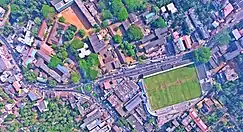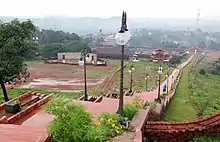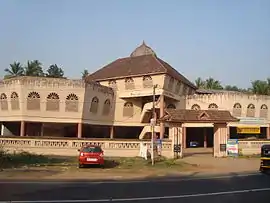Malappuram
Malappuram (also Malapuram) (Malayalam: [mɐlɐpːurɐm] ⓘ)[8] is a city and the headquarters of the Malappuram district in Kerala, India. It is the largest urban agglomeration in Kerala and the 20th largest in India and a city in the Indian state of Kerala, spread over an area of 158.20 km2 (61.08 sq mi) including the surrounding suburban areas. The first municipality in the district formed in 1970, Malappuram serves as the administrative headquarters of Malappuram district. Divided into 40 electoral wards, the city has a population density of 4,800 per square kilometre (12,000 per square mile). According to the 2011 census, the Malappuram metropolitan area is the fourth largest urban agglomeration in Kerala after Kochi, Calicut, and Thrissur urban areas and the 20th largest in India with a total population of 3 million.[9] It is the fastest growing city in the world with a 44.1% urban growth between 2015 and 2020 as per the survey conducted by Economist Intelligence Unit (EIU) based on the urban area growth during January 2020.[10][11] Malappuram is situated 54 km southeast of Calicut and 90 km northwest of Palakkad.[12] It is the first Indian municipal body to provide free Wi-Fi connectivity to its entire residents.[13][14] Malappuram is also the first Indian municipal body to achieve the International Organization for Standardization certificate.[15] It is also the first complaint-free municipality in the state.[16]
Malappuram
Malapuram | |
|---|---|
Clockwise from top: Malappuram Down Hill, Town Hall, Kottakkunnu Hills, Vaidyar Smarakam, AI International College, MDSC Stadium, River view Chaliyar | |
| Nickname(s): City of Hills, Soccer Capital[1]/ Mecca of Football | |
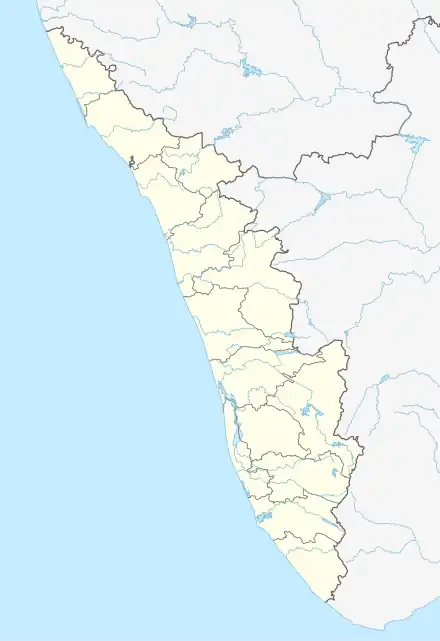 Malappuram Malappuram (Kerala)  Malappuram Malappuram (India) 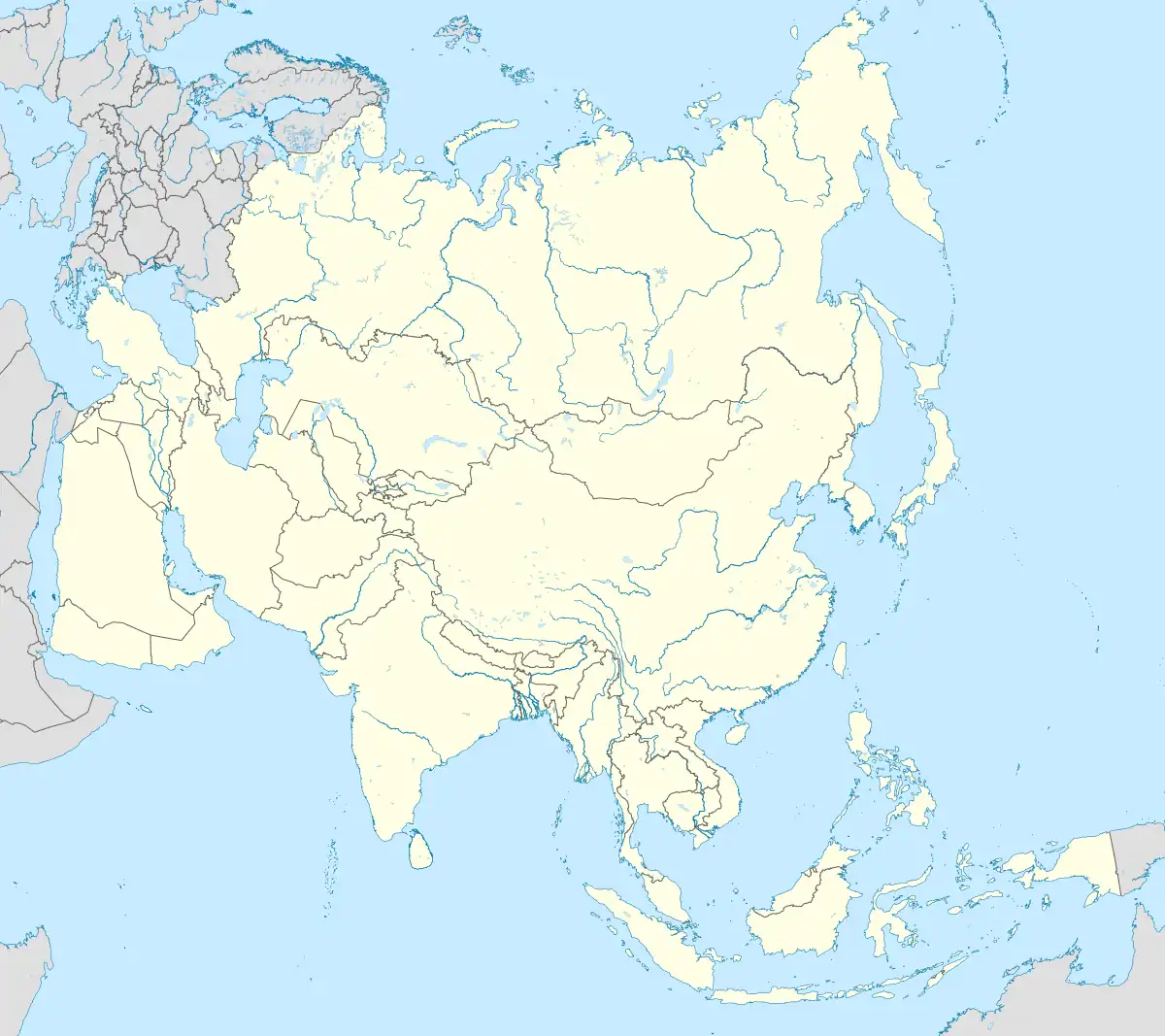 Malappuram Malappuram (Asia) .svg.png.webp) Malappuram Malappuram (Earth) | |
| Coordinates: 11°03′03.6″N 76°04′16.0″E | |
| Country | |
| State | Kerala |
| District | Malappuram |
| Government | |
| • Type | Municipal Council |
| • Body | Malappuram Municipality |
| • Chairman | Mujeeb Kaderi |
| • Deputy Chairperson | Perumpally Said |
| Area | |
| • Metropolis | 158.20 km2 (61.08 sq mi) |
| Elevation | 38.21 m (125.36 ft) |
| Population (2021)[3] | |
| • Metropolis | 629,450[4] |
| • Rank | 20th in Indian |
| • Density | 4,800/km2 (12,000/sq mi) |
| • Metro | 2,829,522 |
| Demonym | Malappuramite[6] |
| Language | |
| • Official | Malayalam.[7] |
| Time zone | UTC+5:30 (IST) |
| PIN | 676505 |
| Telephone code | +91483xxxxxxx |
| Vehicle registration | KL-10
KL-53 KL-54 KL-84 KL-71 |
| Literacy rate | 98.47% |
| Climate | Am/Aw (Köppen) |
| Precipitation | 3,100 millimetres (120 in) |
| Avg. summer temperature | 39 °C (102 °F) |
| Avg. winter temperature | 20 °C (68 °F) |
| Website | www |
Etymology
The term, Malappuram, which means "over the hill" in Malayalam, derives from geography of Malappuram, the administrative headquarters of the district.[17][18] The midland area of district is characterised by several undulating hills such as Arimbra hills, Amminikkadan hills, Oorakam Hill, Cheriyam hills, Pandalur hills, and Chekkunnu hills, all of which lie away from the Western Ghats.[19] However, the coconut-fringed sandy coastal plain is an exception for the general hilly nature.[20][21][22]
History
Malappuram was a military and administrative headquarters from ancient times, though several of the ancient history of the city is hardly seen recorded. However, there are some pre-historic relics, particularly Rock-cut caves found in some parts of the city like Oorakam, Melmuri, Ponmala, Vengara etc. manifesting the inhabitancy.[23] Locality named like Valiyangadi, Kootilangadi, Pallipuram etc. points to the Jain - Buddhist history of Malappuram. Notably, the 1500-year-old Jain Temple above 2000 ft sea level at Oorakam Hill of Malappuram undoubtedly proves the same.[24] During the Sangam period, Eranadan Malappuram was under the Chera Empire. Places like Pattar Kadav, Panakkad, etc. are possibly evolved out of Pattars and Panars having lived there. But no further details are available about the life and culture of the people either during the Sangam age or in the post-Sangam age.[25]
Eranad was ruled by a Samanthan Nair clan known as Eradis, similar to the Vellodis of neighbouring Valluvanad and Nedungadis of Nedunganad. The rulers of Eranad were known by the title Eralppad/Eradi. Archaeological relics found in Malappuram also include the remnants of palaces of the eastern branch of the Zamorin reign. Malappuram was the military headquarters of the Zamorin in the Eranad region. The Zamorins held sway over Malappuram and their chieftain Para Nambi, ruled the area in early days with headquarters at Downhill (Kottappadi), Malappuram.[26] Details of the rulers of erstwhile Malappuram, who were the ancestors of later Zamorins, figure in the Jewish copper plates of Bhaskara Ravi Varman (1000 AD) and in the Kottayam copper plates of Veera Raghava Chakravarthy (1225 AD). The later history of the city is interwoven with the history of Zamorin's rule.[27]
During the colonial era, Malappuram was the headquarters of European and British troops and it later became the headquarters of the Malabar Special Police (M.S.P) formerly known as Malappuram Special Force formed in 1885[28] The British established the Haigh Barracks on top of the hill of Malappuram, at the bank of the Kadalundi river to station their forces, where once Tipu had a fort. Main Barracks has now been turned into the seat of the district administration as Civil Station, Malappuram.[29][25] Malappuram was the headquarters of one of the five revenue divisions of erstwhile Malabar district, the others being at Thalassery, Kozhikode, Palakkad and Fort Cochin.[30] Apart from the District Board at Calicut, Malappuram Taluk Board were one of the local boards constituted to manage the affairs in Malabar District along with Thalassery, Palakkad and Mananthavady (Wayanad) with jurisdiction corresponding to the divisional charges of the same names.[31] Inscription of the Malappuram Taluk Board can still be seen on the wall of one of the remaining wells constructed in 1916, over 100 years ago at Valiyangadi in the city.[32][33] Offices of the Divisional Revenue Magistrate and Assistant Superintendent of Police of Malabar district were located at Malappuram.[34]
Kottakkunnu History
The name Kottakunnu comes from the fort built here when the area was the military headquarters of the Calicut rulers Zamorins. Due to the geographical importance of this area, the fort known as Malappuram Fort was built here and the city of Malappuram came up.
These areas became part of Valluvanad after the Perumal rule of the Chera kingdom that ruled Kerala in ancient times.
At the end of a mountain, the place is a strategic area that is three parts river, one part deep gorge and the upper part is flat like a pedestal. The modern city is spread over the slope of this hill and the plains below.
By the twelfth century, the Eradis of Nediyiruppu Swarupam near Kondotty established a kingdom in South Malabar with their headquarters at Calicut. They were the founders of the Zamorins dynasty. Each of the other kingdoms became a part of Calicut through military operations by land and sea with support of Kshatriya Nair (a martial caste in Hinduism) and Moplah Muslim soldiers. Malappuram and the surrounding area were subjugated from Valluvakonathiri under the leadership of Varakkal Paranambisan. Thacharakavil Eradis, who were the relatives of Nediyiruppu Swarupam defeated Muthan tribes who were the rulers of the Nilambur forest and the region became part of the Zamorins' kingdom. The Muthans, who lost their kingdom through fraud, risked their pride and took refuge in the mountains so as not to live as slaves. Their generation, called Malamuthans (Mala in Malayalam mountain), who are still aloof from other peoples, are scattered in the mountains that are part of the Western Ghats in today's panchayats like Urangattiri, Edavanna, Mampad and Chaliyar. The Eradis of Thacharakavil were the founder of Nilambur Kovilakam. Under head and controller of Calicut port Shah Bandar Koya, with the help of Thirumalasseri Namboothiri and Kalpakanchery Tambrans, attacked Thirunavaya and got the authority from Valluvakonathiri to hold the position of Raksha Purusha (Great protector) in Mamangam ( a 28-day-long trade festival celebrated once every 12 years in Kerala on the banks of the Bharathappuzha). After this incident Valluvakonathiri started to send Chaveras (victory or death army) to kill Zamorin during the Mamangam festival to regain the patronage.
Varakkal Paranabisan, who conquered Malappuram and the surrounding area from Valluvakonathiri, built a fort on top of Kottakunnu. The gates of the fort are the places known today as the commercial center Kottapadi (Fortgate) at Downhill and Moonampadi ( Third gate) on the Nilambur road. Paranambi ruled Ernad with Kottapadi as the headquarters and continued military operations against Valluvanadu and other kingdoms with Kottakkunnu fort as the military center. After the Zamorins conquered the part of the Kadalundi river where the Cherupuzha joins, it became necessary to pay taxes in Malappuram to bring the goods from the Valluvanadu to the Sea port or forced to sell to the traders of Calicut which resulted formation of small trade center in the area called Kootilangadi. During the staring of 18th century the Paranambi of the time was defeated in a battle with Puntrakonathiri, the ruler of Kottakkal, and was captured by the enemy soldiers. The Moplah Muslim traders fought them and released Paranambi. Pleased with this, Paranambi built the famous Jama mosque near the Kadalundi river and a commercial center developed around the mosque known as Valiyangadi. With this, in the early 1700s, Malappuram became a commercial center beyond being a military center.
Apart from Valluvanad, the military operations of Zamorins were threatened, Palakkad's ruler, Palakkattu Achan, who asked for help from Mysore Wodeyar King's Dindigul governor Hyder Ali, Hyder Ali's army conquered Malabar and realizing the failure, the then Zamorin set fire to his ammunition and committed suicide. With this, the mamangam that the Zamorins held the patronage came to an end.
In the meantime, the administration of Mysore came into the hands of Hyder Ali and after Hyder Ali his son Tippu Sultan became the rulers of Malabar under Mysore. During Tippu's time Malappuram fort was developed and cannons, ammunition etc. were brought from Mysore and made into a strong military centre. Many roads were constructed to link Malappuram fort. Malappuram-Thamarassery road, Malappuram-Palakkad road, Malappuram-Feroke road, Malappuram-Parappanangadi road, Malappuram-Kolathur-Pattambi road were the roads built at that time. Tippu Sultan decided to build a fort centered on Feroke as the headquarters of Malabar. The roads were connected with Palakkad Fort, Feroke Fort, Ramagiri Fort near Pattambi, Palur Fort, Thamarassery Pass, Karakur (Nadugani) Pass and Walayar Pass etc..
The agrarian reforms of Tippu Sultan and a Brahmin named Madanna, who was the Receiver Governor of Malabar during the reign of the Mysore Sultans, favored the tenant farmers and cost the landlords. Reforms in taxation according to the level of agricultural production, giving privilege to agricultural land to first-time farmers on barren land, and taxing landlords on their agricultural products caused many landlords to oppose Tippu. Landlords like Pazassi king and Manjeri Athan Kurikkal (Hassan Gurukkal) turned against Tippu along with the British East India company. The Manjeri Athan Kurikkal was the tax collector and ammunition keepers in Manjeri during the reign of Zamorins. Manjeri Kovilakam which was related to Valluvakonathiri, was Tippu's administrative representative in Manjeri . The Athan Kurikkal demolished Manjeri Kovilakam and Tippu came to know about this and captured the Athan Kurikkal in a military operation and imprisoned in Mysore.
In 1792 Tippu sultan defeted by British in the Third Anglo-Mysore War, ceded Malabar to the British alliance under the Treaty of Srirangapattana and released all the prisoners, including the Athan Kurikkal of Malabar. The Malappuram fort came under the control of the Athan Kurikkal. Malabar was annexed by the British to the Bombay Presidency and made a direct colony of Britain and only certain people were empowered to collect taxes. This led to the opposition of Pazhassi King, Athan Kurikkal and others who helped the British against Tippu. British came to know that Pazhassi king was try to start alliance with Tippu, they gave many temptations to Pazhassi and the Athan Kurikkal . But they rejected the temptations and launched many protests against the British. When Tippu was killed at Srirangapatna in 1799, the British retaliated strongly against them.
In 1806, Manjeri Athan Kurikkal was killed in the battle of Mappattukara near Pattambi and thus Malappuram Fort came under the British.
The beautiful view from the top of the Malappuram hill and the gentle breeze made the area a British military base. Some British documents refer to Malappuram hill as one of the most beautiful military bases in India. Malappuram was also known as the last military center of the British Empire in the southern part of India at that time. Malappuram fort was demolished and a gunnery training center was built there. In the 1800s, the anti-British rebellions in South Malabar, known as the Moplah Rebellions, led to the establishment of several military bases in and around Malappuram. A paramilitary unit called Malappuram Special Police was established in Malappuram in 1885. During the Malabar uprising against British empire in 1921, it was raised as the Malabar Special Police. During the Malabar War of 1921, several British military units such as the Leinster Regiment and the Dorset Regiment were encamped in Malappuram. The Leinster Regiment, a military unit of Southern Ireland was the last military alliance with the British soldiers at Malappuram in 1921. After that, Southern Ireland became an independent republic from Britain.
During British rule, a military court was established at Kottakunnu and many freedom fighters were tried and executed.
Variyankunnath Kunjahmad Haji, British rebel ruler during Malabar uprising, and his two assistants were tried and shot dead by the British court on the afternoon of January 20, 1922, on the northern slopes of Kottakunnu. It was there that his body and the documents of the British rebel state he established as the Malayalam Rajyam were burnt. Now Malappuram Municipality has built a town hall in his memory below Kottakunnu.
After British rule in 1947, many British military bases including Kotakunnu in Malappuram came under the Department of Defence under Central Ministry of India . The main military headquarters is the present District Collectorate of Malappuram . Apart from the Malabar Special Police, a paramilitary force under the Kerala Police, other military centers were abolished. In 1956, when Malabar, which was a part of Madras State, was annexed to Kerala State, a section of Malabar Special Police was transferred to Tamil Nadu under the name of Madras Special Police.
Malappuram is a region with the highest number of football fans in India. But there were few spacious places to play football. Big games have to wait until the paddy fields are harvested. As a result of Malappuram Municipality's constant efforts to build an international football stadium, Central Government of India handed over Kottakunnu to the Malappuram Municipality in 1996. But as studies have shown that Kottakunnu is an ecologically fragile area, so the construction of stadium will cause ecological problems. Then the stadium was constructed at Payyanad near Manjeri and instead of the stadium a beautiful garden was built in Kottakunnu. Today many entertainment centers like art gallery, amusement park, children's park etc... have been built there.
On May 17, 1998, the Kudumbasree mission, a women's empowerment scheme of the Government of Kerala, was inaugurated by the Prime Minister Atal Bihari Vajpayee at Kottakunnu.
On August 9, 2019, three people, including a child, died in a landslide in Kottakunnu due to heavy rain.
Geography
Topography
Malappuram is situated in the mid land area of the state. As the name suggests, it is covered with small mountains of lush greenery, bonded with several freshwater streams flowing through the city. Kadalundi Puzha, a major river in Kerala is flowing around the city.[35] Malappuram is one of the few municipalities in the state with a tremendous track record of keeping the city clean. The recognition as second 'best municipality in up keeping the cleanliness and health by state government in 2011[36] and Second prize for Swachhata Excellence Awards in 2019 by Government of India[37] acknowledges these sincere efforts of the municipality. Malappuram is the biggest potential nod of the district. Unlike other district headquarters, Malappuram holds a significant position in west–east transit along with north–south. It makes the city accessible for everyone in the district through either National Highway or State Highway.[38]
Climate
The city has more or less the same climatic conditions prevalent elsewhere in Kerala: a tropical monsoon climate (Köppen Am) that is generally hot and humid in nature. However, the South West Monsoon is usually very heavy. The best season to visit Malappuram is during the months of September to March as the weather conditions are quite pleasant. Owing to its natural habitat, Malappuram is also a city of fresh air. According to the Central Pollution Control Board data for the year 2010, of the 180 cities monitored for SO2, NO2 and PM10, Malappuram was one of the two cities which met the criteria of low pollution (i.e. 50% below the standard) for all air pollutants.
| Climate data for Malappuram, Kerala | |||||||||||||
|---|---|---|---|---|---|---|---|---|---|---|---|---|---|
| Month | Jan | Feb | Mar | Apr | May | Jun | Jul | Aug | Sep | Oct | Nov | Dec | Year |
| Average high °C (°F) | 32.0 (89.6) |
32.9 (91.2) |
34.0 (93.2) |
33.8 (92.8) |
32.7 (90.9) |
29.3 (84.7) |
28.1 (82.6) |
28.7 (83.7) |
29.7 (85.5) |
30.3 (86.5) |
31.1 (88.0) |
31.4 (88.5) |
31.2 (88.2) |
| Average low °C (°F) | 21.8 (71.2) |
22.8 (73.0) |
24.4 (75.9) |
25.4 (77.7) |
25.1 (77.2) |
23.5 (74.3) |
22.8 (73.0) |
23.3 (73.9) |
23.3 (73.9) |
23.4 (74.1) |
23.1 (73.6) |
21.9 (71.4) |
23.4 (74.1) |
| Average rainfall mm (inches) | 1 (0.0) |
9 (0.4) |
16 (0.6) |
101 (4.0) |
253 (10.0) |
666 (26.2) |
830 (32.7) |
398 (15.7) |
233 (9.2) |
281 (11.1) |
140 (5.5) |
24 (0.9) |
2,952 (116.3) |
| Source: [39] | |||||||||||||
Demographics
According to the 2011 Indian Census, city had a total population of 101,386, of which 48,957 were males and 52,429 were females. The population within the age range of 0 to 6 years was 14,629. The Scheduled Castes and Scheduled Tribes population was 5,323 and 77 respectively. Malappuram had 19785 households in 2011.[3] Muslims form 74.83% of the town's population while Hindus and Christian form the remaining 25%.[40]
Civic administration
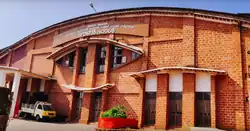
Being the headquarters city, Malappuram comprises the Civil Station area which consists of administrative and other Government offices of the district such as District Collectorate, District Treasury, RTO, PWD Division Office, Jilla Panchayat, Town planning Office, Text depot, District Medical office etc. to name a few. The city is administered by the Malappuram Municipality, headed by a Municipal chairman. For administrative purposes, the city is divided into 40 wards, from which the members of the municipal council are elected for five years. The Chairperson of Malappuram Municipality is Mujeeb Kaderi and the deputy chairperson is Fouziya Kunhippu. The present Malappuram District Collector is K. Gopalakrishnan.[41]
Malappuram Municipality Election 2020[42]
| S.No. | Alliance | Symbol | Number of Councillors |
|---|---|---|---|
| 01 | UDF |  | 25 |
| 02 | LDF | _Logo.svg.png.webp) | 14 |
| 03 | Independents | 01 | |
Law and order
City police are headed by a Dy SP Malappuram. And Office of Superintendent of Police is also at Malappuram. Apart from regular law and order, city police include the Malappuram Traffic Police, Malappuram Vanitha Police Station,[43] which is the only all women station in the district,[44] Crime Branch, Bomb Squad, Dog Squad, Women's Cell, Narcotics Cell, Malabar Special Police, Armed Police Camp, District Crime Records Bureau. Apart from these, there is 24/7 highway police patrol as well as a special pink patrol(Dial-1515) under Malappuram police division catering to women. [45]
Proposed Malappuram Municipal Corporation
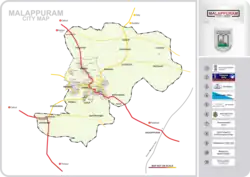
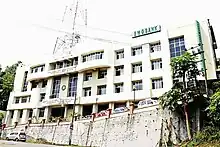
Malappuram is the only city in Kerala with a million-plus urban agglomeration that is yet to be upgraded to a Municipal Corporation. However, there is a demand to upgrade the Malappuram Municipality into a Municipal Corporation by incorporating the local bodies in the Greater Malappuram region.[46] The proposed Malappuram Municipal Corporation comprises:
- Malappuram Municipality
- Manjeri Municipality
- Anakkayam, a suburban panchayat
- Pookkottur, a suburban panchayat
- Trikkalangode, a suburban panchayat
- Morayur, a suburban panchayat
- Kodur, a suburban panchayat
- Koottilangadi, a suburban panchayat
There are also suggestions to include following Local Bodies in Malappuram Municipal Corporation:
- Kottakkal Municipality
- Ponmala
- Othukkungal
- Oorakam
- Kannamangalam
- Parappur
- Vengara
- Makaraparamba
Education

The city has several educational institutions from the school level to higher education. Kendriya Vidyalaya, Malappuram, Jawahar Navodaya Vidyalaya, Malappuram, Malabar Special Police HSS, Government Girls Higher secondary school, Govt. Boys, St.Gemmas HSS, Islahiya HSS, A.U.P School, Sree Arunodaya Vidya Nigethan etc. to name a few schools. Government College, Malappuram, which is the oldest college in the district started in 1972,[47] College of Applied Science Malappuram started in 1987[48] and Govt. College for Women, Malappuram[49] started in the year 2015 along with many other private colleges serves the higher educational purpose. Govt.TTI, Malappuram,[50] MCT TTI[51] and Fazfari TTI[52] are few teachers training institutes. MCT College of Legal Studies, one of the two law colleges in the district is located in the city.[53] The Regional Directorate of Higher Secondary Education[54] and Regional Office (Malabar) of State Open School[55] are located in the city inside the Civil Station.
The district plays a significant role in the higher education sector of the state. It is home to two of the main universities in the state- the University of Calicut centered at Tenhipalam which was established in 1968 as the second university in Kerala,[56] and the Thunchath Ezhuthachan Malayalam University centered at Tirur which was established in the year 2012.[57] AMU Malappuram Campus, one of the three off-campus centres of Aligarh Muslim University (AMU) is situated in Cherukara, which was established by the AMU in 2010.[58][59] An off-campus of the English and Foreign Languages University functions at Panakkad.[60] The district is also home to a subcentre of Kerala Agricultural University at Thavanur, and a subcentre of Sree Sankaracharya University of Sanskrit at Tirunavaya. The headquarters of Darul Huda Islamic University is at Chemmad, Tirurangadi. INKEL Greens at Malappuram provides an educational zone with the industrial zone.[61] Eranad Knowledge City at Manjeri is a first of its kind project in the state.[62] The MES College of Engineering, Kuttippuram, is the first established engineering college under the self financing sector in Kerala, an urban campus that extends more than a mile (1.6 km) alongside the Bharathappuzha river. The KCAET at Thavanur established in 1963, is the only agricultural engineering institute in the state. The Govt Ayurveda Research Institute for Mental Disease at Pottippara near Kottakkal is the only government Ayurvedic mental hospital in Kerala. It is also the first of its type under the public sector in the country. The Government of Kerala has proposed to establish one more university, the Ayurveda University, at Kottakkal.
The district has the most schools as well as most number of students in Kerala as per the school statistics of 2019–20. There are 898 Lower primary schools,[63] 363 Upper primary schools,[64] Besides these, there are 120 CBSE schools and 3 ICSE schools.
Media
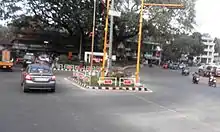
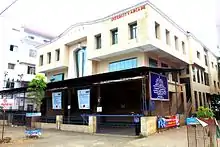
Malayala Manorama, Mathrubhumi, Madhyamam, Chandrika, Deshabhimani, Suprabhaatham dailies have their printing centres in and around the city. The Hindu has an edition and printing press at Malappuram. A few periodicals-monthlies, fortnightlies and weeklies-mostly devoted to religion and culture are also published. Almost all Malayalam channels and newspapers have their bureau at Up Hill. There are some local cable TV channels including (MCV), (ACV) etc. Malappuram Press Club is also situated at UP Hill adjacent to Municipal Town Hall. Doordarshan has its major relay station in the district at Malappuram. Government of India's Prasarbharati National Public Service Broadcaster has FM station in the district, broadcasting on 102.7 Mhtz. Even without any private FM stations, Malappuram finds a place in Top Ten Towns with Highest Radio Listenership in India.[65] There is a multiplex and four standalone cinema halls that screen movies in Malayalam, Tamil, English and Hindi. Rasmi Film Society, one of Kerala's oldest film forums is from Malappuram. The 72nd International film festival of Malappuram was conducted in March 2011.[66] The government of India's Prasar Bharati National Public Service Broadcaster has an FM station in the district (AIR Manjeri FM), broadcasting on 102.7 Mhtz. Even without any private FM stations, Malappuram, Ponnani, and Tirur, find their own places in the ten towns with the highest radio listenership in India.[65]
Sports
Malabar Special Police HSS is one of the best achievers in the Indian inter-school football tournaments.[67] It is also the runner up team of 53rd and 55th Subroto Cup international football tournament held at Delhi.[68] The Kottappadi Football Stadium is located right at the heart of the CBD of Malappuram.[69] The Malappuram District Sports Complex Stadium is situated at Payyanad in Manjeri. It was selected as one of two stadiums, along with the Jawaharlal Nehru Stadium, to host the group stages of the 2013–14 Indian Federation Cup.[70] The stadium hosted groups B and D.[70]
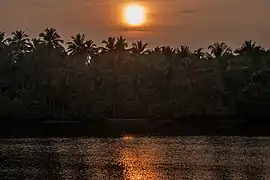
Notable people
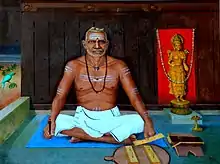
- Kurukkoli Moideen - Politician, MLA.
- A. Vijayaraghavan - Former member of Rajya Sabha and the state secretary of CPI(M).
- A. P. Anil Kumar - Former minister of Kerala.
- A. R. Raja Raja Varma - Malayalam poet and grammatician known as Kerala Panini (belongs to Parappanad royal family).
- Abdul Nediyodath - Footballer.
- Abdurahiman Randathani - Politician.
- Achyutha Pisharadi - a Sanskrit grammarian, astronomer and mathematician.
- Adil Ibrahim - Actor.
- Ahmad Kutty - North American Islamic scholar.
- Ajijesh Pachat - Malayalam novelist, short story writer and columnist.
- Akkitham Achuthan Namboothiri - Malayalam poet and essayist. (Born at Kumaranellur, a border village between Malappuram and Palakkad districts. He was a writer from the Ponnani Kalari)
- Akkitham Narayanan - painter.
- Ammu Swaminathan - Independence activist and a member of Constituent Assembly of India.
- Anas Edathodika - Indian professional footballer.
- Aneesh G. Menon - Actor.[71][72]
- Anikha - Actress.
- Aparna Nair - Actress.
- Arjun Jayaraj - Professional footballer.
- Artist Namboothiri - painter.
- Aryadan Muhammed - Former minister of Kerala.
- Aryadan Shoukath - Indian film producer.
- Ashique Kuruniyan - Indian professional footballer.
- Asif Saheer - Indian soccer player.
- Azad Moopen - Doctor and Philanthropist.[73][74][75]
- B. M. Kutty - Journalist and Activist.
- Balamani Amma - Writer of Malayalam literature.
- C. Karunakara Menon - Journalist and Politician.
- C. Radhakrishnan - Writer and film director of Malayalam language.
- C. N. Ahmad Moulavi - Indian writer of Malayalam literature.
- Chakkeeri Ahemed Kutty - Former minister of Kerala and former speaker of Kerala Legislative Assembly.
- Chalilakath Kunahmed Haji - Social reformer.[76]
- Cherukad Govinda Pisharody - Malayalam playwright, Novelist, Poet, and Political activist.
- Damodara - Astronomer-mathematician.
- Deepu Pradeep - Scriptwriter.
- Devdutt Padikkal - Indian cricketer.
- Dhanish Karthik - Actor.
- Dileep K. Nair - Educationist, skill development campaigner, social activist, and publisher.
- E. Harikumar - Malayalam novelist and short story writer.
- E. Moidu Moulavi - Indian freedom fighter, and an Islamic scholar.[77]
- E. Sreedharan - Metroman of India.
- E. K. Imbichi Bava - Politician.
- E. M. S. Namboodiripad - The first Chief Minister of Kerala and the founder of CPI(M).[78]
- E. T. Mohammed Basheer - Former minister of Kerala and Member of Lok Sabha.
- Edasseri Govindan Nair - Poet.
- Elamaram Kareem - Former minister of Kerala and Member of Rajya Sabha.
- Faisal Kutty - Lawyer, academic, writer, public speaker, and human rights activist.[79]
- Gopinath Muthukad - magician, and motivational speaker.[80][81]
- Govinda Bhattathiri - Indian astrologer and astronomer.
- Hari Nair - Cinematographer.
- Hemanth Menon - Actor.
- Indrajith Sukumaran - film actor and playback singer.
- Nida Anjum Chelat - Indian equestrian.
- Iqbal Kuttippuram - Screenwriter and homoeopathic physician.[82]
- Jayasree Kalathil - Writer, translator, mental health researcher, and activist.
- Jishnu Balakrishnan - Professional footballer.
- K. Abdurahman - Founder of Chaliyar movement.[83]
- K. Avukader Kutty Naha - Former deputy chief minister of Kerala.
- K. C. S. Paniker - was a metaphysical and abstract painter.
- K. C. Manavedan Raja - Indian aristocrat.
- K. M. Asif - Cricketer.
- K. M. Maulavi - Indian freedom fighter, social reformer and the founding vice-president of IUML Malabar district committee.[84][85]
- K. P. A. Majeed - Former Chief Whip of the Government of Kerala.
- K. P. Ramanunni - Novelist and Short-story writer.[86][87]
- K. T. Irfan - Athlete.[88][89][90]
- K. T. Jaleel - Minister of Kerala.
- K. T. Muhammed- Malayalam playwright and screenwriter.
- K. V. Rabiya - Social worker.
- K. V. Ramakrishnan - Malayalam–language poet and journalist.
- Kadavanad Kuttikrishnan - Malayalam poet and journalist.
- Kalamandalam Kalyanikutty Amma - Resurrector of Mohiniyattam.
- Kamala Surayya - Writer of Malayalam literature.
- Kerala Varma Valiya Koil Thampuran - Malayalam poet and translator, also known as Kalidasa of Kerala (belongs to Parappanad royal family).
- Krishnachandran - Actor, Dubbing artist, and Playback singer.
- Kuttikrishna Marar - Essayist and literary critic of Malayalam literature.
- Lakshmi Sahgal - a revolutionary of the Indian independence movement, an officer of the Indian National Army, and the Minister of Women's Affairs in the Azad Hind government.
- M. Govindan - Writer of Malayalam literature.
- M. Swaraj - Politician.
- M. G. S. Narayanan - Historian, and academic and political commentator.
- M. K. Vellodi - Former Indian diplomat.
- M. M. Akbar - Islamic scholar, and an expert in comparative religion.[91]
- M. P. Abdussamad Samadani - Former member of Rajya Sabha.
- M. P. M. Ahammed Kurikkal - Former minister of Kerala.
- M. P. M. Menon - Indian diplomat, ambassador to several countries.[92]
- M. T. Vasudevan Nair - Malayalam author, screenplay writer and film director. (Born at Kudallur, a border village between Malappuram and Palakkad districts. He is a writer from the Ponnani Kalari.)
- Malayath Appunni - Malayalam language poet and children's writer.
- Manjalamkuzhi Ali - Former minister of Kerala.
- Mankada Ravi Varma - Cinematographer and Director.[93][94][95]
- Manorama Thampuratti - was a Sanskrit writer.
- Mashoor Shereef - Professional footballer.
- Melattur Sahadevan - Carnatic music vocalist.
- Melpathur Narayana Bhattathiri - Mathematical linguist.
- Mohammed Irshad - Professional footballer.
- Mohamed Salah - Footballer.
- Mohanakrishnan Kaladi - Malayalam poet.
- Moyinkutty Vaidyar - Mappila pattu poet.[96]
- Mrinalini Sarabhai - Indian classical dancer.
- Muhammad Musthafa - Actor and Director.
- Muhsin Parari - Director, Writer, and Lyricist.
- Nalakath Soopy - Former minister of Kerala.
- Nalapat Narayana Menon - Writer of Malayalam literature.
- Nandanar - Writer of Malayalam literature.
- Nilambur Ayisha - Actress in the Malayalam film industry and drama.
- Nilambur Balan - Malayalam actor.
- Nirupama Rao - Former foreign secretary of India.[97][98]
- P. Sreeramakrishnan - current speaker of Kerala Legislative Assembly.
- P. Surendran - Writer, Columnist, art critic, and a philanthropist.[99]
- P. K. Abdu Rabb - Former minister of Kerala.
- P. K. Kunhalikutty - Former minister of Kerala.
- P. K. Warrier - Ayurvedic physician and a Padma Bhushan winner.
- P. P. Ramachandran - Malayalam poet.
- P. V. Abdul Wahab - Businessman, and a member of Rajya Sabha.
- Paloli Mohammed Kutty - Former minister of Kerala.
- Parameshvara - Indian mathematician and astronomer.
- Parvathy Jayadevan - Playback singer.
- Poonthanam Nambudiri - Malayalam poet.[100]
- Premji - Social reformer, Cultural leader, and Actor.
- Prithviraj Sukumaran - actor, director, producer, playback singer, and distributor.
- Pulapre Balakrishnan - Economist and Educationalist.
- Pulikkottil Hyder - Mappila pattu poet.[101]
- Rajeev Nair - Writer, Lyricist, and Producer.
- Ranjith Padinhateeri - Biological physicist and a professor.
- Rashin Rahman - Actor.
- Raja Ravi Varma - Indian painter and artist (belongs to Parappanad royal family).
- Ravi Menon - Actor.
- Ravi Vallathol - Actor.
- Rinshad Reera - Student Activist.
- Salam Bappu - Film director.
- Salman Kalliyath - Indian professional footballer.
- Sangita Madhavan Nair - Actress.
- Sankaran Embranthiri - Kathakali musician.
- Savithri Rajeevan - Indian poet, short story writer, and painter.
- Sayyid Sanaullah Makti Tangal - Social reformer.[102][103]
- Shahabaz Aman - Playback singer and Composer.[104][105]
- Shanavas K Bavakutty - Film director.
- Shweta Menon - Model, Actress, and Television anchor.
- Sithara - Playback singer, Composer, and an occasional actor.[106]
- Sooraj Thelakkad - An actor.
- Sukumaran - Film actor and producer.
- Sunny Wayne - Film actor (stayed during higher education).
- Syed Muhammedali Shihab Thangal - Religious leader and politician.[107]
- T. A. Razzaq - Screenwriter.
- T. K. Hamza - Former minister of Kerala.
- T. K. Padmini - Indian painter.
- T. M. Nair - Political activist of Dravidian movement.
- Thunchaththu Ezhuthachan- Father of Malayalam language.[108][109]
- Tirur Nambissan - Kathakali singer.
- U. A. Beeran - Former minister of Kerala.
- U.Jimshad - Professional footballer.
- U. Sharaf Ali - Former Indian International football player.[110][111]
- Unni Menon - Playback singer.
- Uroob - Writer of Malayalam literature.
- V. C. Balakrishna Panicker - Indian poet and writer.
- V. T. Bhattathiripad - Social reformer (hailed from erstwhile Ponnani taluk).
- Vaidyaratnam P. S. Warrier - Ayurvedic physician.[112]
- Vaidyaratnam Triprangode Moossad - Ayurvedic physician.
- Vallathol Narayana Menon - Malayalam poet.[113]
- Variyan Kunnathu Kunjahammed Haji - Indian Freedom Fighter.[114]
- Vazhenkada Kunchu Nair - Kathakali master and a Padma Shri winner.
- Vazhenkada Vijayan - Retired principal of Kerala Kalamandalam.
- Veliyankode Umar Khasi - Freedom fighter and poet.
- Vinay Govind - Indian film director.
- Zainuddin Makhdoom II - The author of Tuhfat Ul Mujahideen.
- Zakariya Mohammed - Film director, screenwriter, and actor.[115][116]
- Zakeer Mundampara - Footballer.
See also
References
- "Soccer Capital". The Indian Express.
- "Malappuram census handbook" (PDF). censusindia.gov.in.
- "Census of India: Malappuram". www.censusindia.gov.in. Retrieved 23 January 2020.
- "Malappuram census handbook" (PDF). censusindia.gov.in.
- "Urban Agglomerations/Cities having population 1 million and above" (PDF). The Registrar General & Census Commissioner, India. Retrieved 19 November 2011.
- "Malappuram's first book stall bids adieu". The Hindu. 19 December 2018. Retrieved 4 July 2020.
- "52nd REPORT OF THE COMMISSIONER FOR LINGUISTIC MINORITIES IN INDIA" (PDF). nclm.nic.in. Ministry of Minority Affairs. Archived from the original (PDF) on 25 May 2017. Retrieved 29 March 2019.
- "Revised List of Classification Cities for HRA of central government employees - Govt. Employees India". 2 June 2015.
- "Trends of urbanisation in Kerala" (PDF). Census of India.
- "3 of world's 10 fastest-growing urban areas are in Kerala: Economist ranking". 8 January 2020. Retrieved 13 January 2020.
- "Malappuram is world's fastest-growing city; Kozhikode, Kollam also in top 10". www.newindianexpress.com.
- "malappuram Web". Retrieved 28 July 2015.
- "Malappuram of Kerala to log on to free Wi-Fi". www.thehindu.com. 30 July 2015. Retrieved 1 July 2020.
- "Malappuram Municipality To Be India's First To Offer Free Wi-Fi Connectivity". thelogicalindian.com. 22 August 2015. Retrieved 1 July 2020.
- Staff Reporter (24 February 2014). "First-in-India ISO tag for Malappuram". The Hindu. Retrieved 29 July 2020.
- Abdul Latheef, Naha (2 November 2014). "Malappuram aims to be complaint-free". The Hindu. Retrieved 29 July 2020.
- "Malappuram, The Hill Top Town". nativeplanet.com. 30 June 2014. Archived from the original on 7 June 2020. Retrieved 4 July 2020.
- "Cultural counterpoint". The Financial Express. 24 March 2013. Archived from the original on 7 June 2020. Retrieved 4 July 2020.
- Akash Singh (7 May 2018). "Hilly areas of Malappuram". Native Planet. Archived from the original on 17 October 2020. Retrieved 11 October 2020.
- "District Profile". spb.kerala.gov.in. Retrieved 24 August 2019.
- Travel Guide from native planet
- Cultural Malappuram | Financial Express
- "History of Malappuram" (PDF). censusindia.gov.in.
- "Oorakam Mala". www.cpreecenvis.nic.in. Retrieved 24 August 2019.
- DISTRICT CENSUS HANDBOOK. DIRECTORATE OF CENSUS OPERATIONS, KERALA. 2011. p. 15.
- Logan, William. MALABAR MANUAL: With Commentary by VED from VICTORIA INSTITUTIONS (Volume 2 ed.). VICTORIA INSTITUTIONS, Aaradhana, DEVERKOVIL 673508. Retrieved 12 July 2020.
- PART XII-A (2011). DISTRICT CENSUS HANDBOOK MALAPPURAM. DIRECTORATE OF CENSUS OPERATIONS, Kerala. p. 15.
- C.A., Innes (1908). Madras District Gazetteers: Malabar and Anjengo. Government Press, Madras. p. 371. Retrieved 30 September 2020.
- Malappuram British History
- 1951 census handbook - Malabar district (PDF). Chennai: Government of Madras. 1953. p. 1.
- C.A., Innes (1908). Madras District Gazetteers: Malabar and Anjengo. Government Press, Madras. p. 373. Retrieved 30 September 2020.
- Celebrating centenary of a public well
- Deshabhimani - 100 year old well
- C.A., Innes (1908). Madras District Gazetteers: Malabar and Anjengo. Government Press, Madras. p. 416. Retrieved 30 September 2020.
- "Malappuram District Profile". Malappuram.
- Sivaramakrishnan, K. C. (4 August 2011). Re-visioning Indian Cities: The Urban Renewal Mission. SAGE Publishing India. ISBN 9788132119470.
- "Amrut Cities--Municipal Corporations of Raigarh, Ambikapur, and Kumbakonam Bag Top Swachhata Excellence Awards". pib.gov.in. Retrieved 24 August 2019.
- Work Study Report on Police Department 2013. P & A R (AR-VII) DEPARTMENT, Government of Kerala. 2013. p. 77.
- ""CLIMATE: MALAPPURAM"". Climate-Data.org.
- https://www.census2011.co.in/data/religion/district/275-malappuram.html
- Staff Reporter (27 May 2020). "New Malappuram Collector takes charge". Keralakoumudi. Retrieved 1 July 2020.
- "Malappuram Municipality election 2020". lbtrend. Retrieved 11 December 2020.
- Malappuram Police
- Malappuram Vanitha Station Inaugurated
- http://www.malappurampolice.gov.in/mlpol/
- "Proposed Malappuram Municipal Corporation". timesofindia.indiatimes.com. 16 May 2014. Retrieved 29 June 2020.
- "History – Govt College Malappuram".
- CAS Malappuram
- GWC Malappuram
- GTTI Malappuram
- MCT TTI
- TTI Padinhattumuri Malappuram
- MCT Law College Address
- DHSE Portal
- SCOLE Kerala
- "The University of Calicut". uoc.ac.in.
- "Malayalam University". malayalamuniversity.edu.in.
- "Aligarh Muslim University Malappuram Off-centre". amu.ac.in.
- "Universities in Malappuram district". malappuramtourism.org.
- "Eflu to start courses in Malappuram campus on January-31". The Times of India. 17 January 2014. Retrieved 24 June 2020.
- "Inkel Greens beckons firms to Malappuram". The Hindu Businessline. 28 June 2016. Retrieved 6 October 2020.
- "Eranad knowledge city". eku.edu.in. Retrieved 4 November 2020.
- "LP schools in Malappuram". sametham.kite.kerala.gov.in. Retrieved 17 April 2020.
- "UP schools in Malappuram". sametham.kite.kerala.gov.in. Retrieved 17 April 2020.
- "Top Ten Towns with Highest Radio Listenership". Retrieved 28 July 2015.
- "Rasmi film fete concludes". The Hindu. Chennai, India. 15 March 2011.
- "MSP HSS emerges champion". The Hindu. Chennai, India. 10 January 2012.
- Press Trust of India (1 October 2012). "Dynamo Kyiv down fighting MSP Malappuram to win Subroto Cup". Business Standard India. Retrieved 28 July 2015.
- "Where Malappuram learned to play football". www.newindianexpress.com. 29 December 2014. Retrieved 1 July 2020.
- "Federation Cup 2013-14 to kickoff on January 14". The Times of India. Archived from the original on 13 January 2014. Retrieved 12 January 2014.
- "Being the usual and unusual actor: Aneesh G Menon". Deccan Chronicle. 19 September 2017.
- Pillai, Radhika C (9 March 2015). "Length of the character matters to me: Aneesh". The Times of India. Retrieved 1 April 2021.
- Jagwani, Lohit (12 February 2014). "We are looking at a turnover of $1B by 2017: Azad Moopen, chairman of Aster DM Healthcare". VC Circle. Retrieved 5 May 2014.
- Padma Awards Announced Ministry of Home Affairs, 25 January 2011
- "Top 100 Indian Leaders in UAE". Forbes. Archived from the original on 5 May 2014. Retrieved 5 May 2014.
- H. Abdul Rahman (6 April 2009). "Vakkom Moulavi and the Renaissance Movement among the Muslims". University. Conclusion: University of Kerala-Shodhganga: 257. hdl:10603/164340. Retrieved 21 March 2020.
- "Nationalism now linked to mob psychology". The Hindu. 8 June 2017. Retrieved 12 March 2020.
- Singh, Kuldip (1 April 1998). "Obituary: E. M. S. Namboodiripad". The Independent. Retrieved 20 May 2018.
- "VU law professor among world's most influential Muslims". nwitimes.com. 31 December 2012. Retrieved 18 February 2013.
- "Indian magician performs Houdini-like escape". Rediff.com. 14 February 1997. Retrieved 3 May 2017.
- "2011 Yearbook". International Magicians Society. Archived from the original on 20 August 2016. Retrieved 20 August 2016.
- "A chest of stories". Archived from the original on 25 July 2011. Retrieved 23 March 2020.
- "Honouring a legend of the Chaliyar". The Hindu. 10 January 2009. Archived from the original on 7 November 2012. Retrieved 25 January 2021.
- "Article". Samakalika Malayalam Weekly. 19 (48): 47. 22 April 2016. Retrieved 27 May 2020.
- Muhammed Rafeeq. Development of Islamic movement in Kerala in modern times (PDF). Islahi Movement. p. 115. Retrieved 24 October 2019.
- "Vayalar award for K.P. Ramanunni". The Hindu. 8 October 2011. Retrieved 12 October 2011.
- "manorama online-english". Archived from the original on 3 April 2012. Retrieved 12 October 2011.
- "Irfan qualifies for Olympics in 20 km walk.He completed the walk by touching the finish line at 10th position". dailysports.co. Archived from the original on 29 March 2014. Retrieved 2 July 2012.
- "Khushbir fails after Irfan qualifies for Olympics in 20 km walk". The Times of India. Archived from the original on 26 January 2013. Retrieved 2 July 2012.
- "Irfan Thodi". The Times of India. Retrieved 19 July 2013.
- "Arab News". Arab News.
- "Indian community in UAE mourns death of diplomat", Gulf News, Abu Dhabi, 14 February 2013. Retrieved 14 February 2013.
- S Nanda Kumar. "Directpr's Cut". Deccan Herald. Retrieved 23 November 2010.
- "Painting with light". The Hindu. Chennai, India. 7 September 2007. Archived from the original on 3 December 2007.
- Dore, Shalini (24 November 2010). "Indian cinematographer Varma dies: He worked on Adoor Gopalakrishnan's films". Variety.
- "Mappila songs cultural fountains of a bygone age, says MT". The Hindu. Chennai, India. 31 March 2007. Archived from the original on 8 November 2012. Retrieved 15 August 2009.
- Nirupama Rao takes over as Foreign Secy Press Trust of India / New Delhi, Business Standard, 1 August 2009.
- Nirupama Rao is India's new foreign secretary The Times of India, 1 August 2009."Chokila Iyer was first woman, Indian Foreign Secretary in 2001."
- "Award for Short Stories". keralasahityaakademi.org. Archived from the original on 5 July 2017. Retrieved 27 October 2015.
- I K K Menon (1995). FOLK TALES OF KERALA. Publications Division Ministry of Information & Broadcasting Government of India. pp. 194–. ISBN 978-81-230-2188-1.
- "The Official Website of Malappuram District". Archived from the original on 29 June 2010. Retrieved 25 November 2010.
- Journal of Kerala Studies Volume 9. (1982): 84.
- Mohammed, U. Educational Empowerment of Kerala Muslims. Calicut (Kerala): Other Books, 2017. 33.
- ""Shaam-e-Ehsas" Ghazal Nite by Shahabaz Aman". Hello Bahrain. 29 March 2012. Archived from the original on 13 December 2013. Retrieved 9 December 2013.
- "Shahabaz Aman: When I die, I'd rather have people say that Malabar's renowned romantic passed away than just a singer". The Times of India. Retrieved 14 June 2019.
- "Sithara goes to Kollywood". The Times of India. 2 March 2012. Archived from the original on 16 February 2013.
- "President, PM, Sonia pay homage to IUML leader Thangal". The Times of India. 2 August 2009. Archived from the original on 12 June 2012.
- Lewis, M. Paul, Gary F. Simons, and Charles D. Fennig (eds. "Malayalam" Ethnologue: Languages of the World. 2014: (Dallas, Texas) Web. 29 September 2014.
- K. SANTHOSH. "When Malayalam found its feet" THRISSUR, 17 July 2014 The Hindu
- "Minister convenes high-level meet". The Hindu. 4 July 2009. Archived from the original on 7 July 2009. Retrieved 10 October 2009.
- "Department of Physical Education". Calicut University. Archived from the original on 25 July 2008. Retrieved 10 October 2009.
- mail at aryavaidyasala dot com. "ARYA VAIDYA SALA - Kottakkal". aryavaidyasala.com. Retrieved 22 March 2015.
- Zarrilli, Phillip (2004). Kathakali Dance-Drama: Where Gods and Demons Come to Play. Routledge. pp. 30–31. ISBN 9780203197660.
- EncyclopaediaDictionaryIslamMuslimWorld Volume 6. 1988. p. 460.
Contemporary evaluation within India tends to the view that the Malabar Rebellion was a war of liberation, and in 1971 the Kerala Government granted the remaining active participants in the revolt the accolade of Ayagi, "freedom fighter"
- "Aravindan Puraskaram awarded to Zakariya Mohammed - Times of India". The Times of India.
- "Sudani from Nigeria wins audience choice award at Russian film festival". The New Indian Express.
